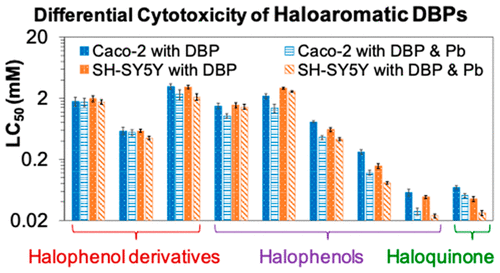当前位置:
X-MOL 学术
›
Chem. Res. Toxicol.
›
论文详情
Our official English website, www.x-mol.net, welcomes your
feedback! (Note: you will need to create a separate account there.)
Differential Cytotoxicity of Haloaromatic Disinfection Byproducts and Lead Co-exposures against Human Intestinal and Neuronal Cells.
Chemical Research in Toxicology ( IF 3.7 ) Pub Date : 2020-08-17 , DOI: 10.1021/acs.chemrestox.0c00157 Jiaqi Liu 1 , Cody Olson 1 , Ning Qiu 2 , Christie M Sayes 1
Chemical Research in Toxicology ( IF 3.7 ) Pub Date : 2020-08-17 , DOI: 10.1021/acs.chemrestox.0c00157 Jiaqi Liu 1 , Cody Olson 1 , Ning Qiu 2 , Christie M Sayes 1
Affiliation

|
Disinfecting drinking water with chlorine inadvertently generates disinfection byproducts (DBPs) which can cause potential adverse health effects to humans. Haloaromatic DBPs are a group of emerging DBPs recently identified, suspected to be substantially more toxic than haloaliphatic DBPs but have not been extensively studied. Simultaneously, service pipelines made of lead materials are widely used in water distribution systems and become a source of dissolved lead (Pb) in tap water. In this study, we investigated the cytotoxicity of nine haloaromatic DBPs and lead ion (Pb2+), both separately as well as in combination, to human epithelial colorectal adenocarcinoma (Caco-2) and neuroblastoma (SH-SY5Y) cells. Results show that the cytotoxicity of the DBPs against Caco-2 cells followed the descending rank order of 2,4,6-triiodophenol ≅ 2,5-dibromohydroquinone > 2,4,6-tribromophenol > 3,5-dibromo-4-hydroxybenzaldehyde ≅ 2,4,6-trichlorophenol > 4-chlorophenol ≅ 3,5-dibromo-4-hydroxybenzoic acid > 2,6-dichlorophenol >5-chlorosalicylic acid, and the cytotoxicity of the DBPs against SH-SY5Y cells followed a similar rank order, 2,4,6-triiodophenol ≅ 2,5-dibromohydroquinone > 2,4,6-tribromophenol > 3,5-dibromo-4-hydroxybenzaldehyde ≅ 2,4,6-trichlorophenol > 4-chlorophenol > 3,5-dibromo-4-hydroxybenzoic acid > 2,6-dichlorophenol ≅ 5-chlorosalicylic acid. Lead in water did not change the toxicity of 3,5-dibromo-4-hydroxybenzoic acid (to either cell-type) or the toxicity of 4-chlorophenol (to the neuronal cell-type); but Pb2+ exhibited different degrees of synergistic effects with other tested DBPs. The synergism resulted in different rank orders of cytotoxicity against both intestinal and neuronal cells. These data indicate that future prioritization and regulation of emerging haloaromatic DBPs in drinking water should be considered in terms of their own toxicity and combinatorial effects with lead in water.
中文翻译:

卤代芳烃消毒副产物的差异细胞毒性和铅对人类肠道和神经元细胞的共同暴露。
用氯对饮用水进行消毒会在不经意间产生消毒副产物 (DBP),这会对人类健康造成潜在的不利影响。卤代芳香族 DBP 是最近发现的一组新兴 DBP,怀疑其毒性比卤代脂肪族 DBP 大得多,但尚未得到广泛研究。同时,由铅材料制成的服务管道广泛用于配水系统,成为自来水中溶解铅(Pb)的来源。在本研究中,我们研究了九种卤代芳香族 DBP 和铅离子(Pb 2+),无论是单独还是组合,对人上皮结肠直肠腺癌 (Caco-2) 和神经母细胞瘤 (SH-SY5Y) 细胞。结果表明,DBPs对Caco-2细胞的细胞毒性依次为2,4,6-三碘苯酚≅2,5-二溴氢醌>2,4,6-三溴苯酚>3,5-二溴-4-羟基苯甲醛≅ 2,4,6-三氯苯酚 > 4-氯苯酚 ≅ 3,5-二溴-4-羟基苯甲酸 > 2,6-二氯苯酚 > 5-氯水杨酸,DBPs 对 SH-SY5Y 细胞的细胞毒性排名相似顺序,2,4,6-三碘苯酚 ≅ 2,5-二溴氢醌 > 2,4,6-三溴苯酚 > 3,5-二溴-4-羟基苯甲醛 ≅ 2,4,6-三氯苯酚 > 4-氯苯酚 > 3,5-二溴-4-羟基苯甲酸> 2,6-二氯苯酚≅ 5-氯水杨酸。水中的铅没有改变 3,5-二溴-4-羟基苯甲酸(对任一细胞类型)的毒性或 4-氯苯酚(对神经元细胞类型)的毒性;但铅2+与其他测试的 DBP 表现出不同程度的协同作用。协同作用导致对肠细胞和神经元细胞的不同级别的细胞毒性。这些数据表明,未来对饮用水中新出现的卤代芳香族 DBP 的优先排序和监管应考虑其自身的毒性和与水中铅的组合效应。
更新日期:2020-09-21
中文翻译:

卤代芳烃消毒副产物的差异细胞毒性和铅对人类肠道和神经元细胞的共同暴露。
用氯对饮用水进行消毒会在不经意间产生消毒副产物 (DBP),这会对人类健康造成潜在的不利影响。卤代芳香族 DBP 是最近发现的一组新兴 DBP,怀疑其毒性比卤代脂肪族 DBP 大得多,但尚未得到广泛研究。同时,由铅材料制成的服务管道广泛用于配水系统,成为自来水中溶解铅(Pb)的来源。在本研究中,我们研究了九种卤代芳香族 DBP 和铅离子(Pb 2+),无论是单独还是组合,对人上皮结肠直肠腺癌 (Caco-2) 和神经母细胞瘤 (SH-SY5Y) 细胞。结果表明,DBPs对Caco-2细胞的细胞毒性依次为2,4,6-三碘苯酚≅2,5-二溴氢醌>2,4,6-三溴苯酚>3,5-二溴-4-羟基苯甲醛≅ 2,4,6-三氯苯酚 > 4-氯苯酚 ≅ 3,5-二溴-4-羟基苯甲酸 > 2,6-二氯苯酚 > 5-氯水杨酸,DBPs 对 SH-SY5Y 细胞的细胞毒性排名相似顺序,2,4,6-三碘苯酚 ≅ 2,5-二溴氢醌 > 2,4,6-三溴苯酚 > 3,5-二溴-4-羟基苯甲醛 ≅ 2,4,6-三氯苯酚 > 4-氯苯酚 > 3,5-二溴-4-羟基苯甲酸> 2,6-二氯苯酚≅ 5-氯水杨酸。水中的铅没有改变 3,5-二溴-4-羟基苯甲酸(对任一细胞类型)的毒性或 4-氯苯酚(对神经元细胞类型)的毒性;但铅2+与其他测试的 DBP 表现出不同程度的协同作用。协同作用导致对肠细胞和神经元细胞的不同级别的细胞毒性。这些数据表明,未来对饮用水中新出现的卤代芳香族 DBP 的优先排序和监管应考虑其自身的毒性和与水中铅的组合效应。











































 京公网安备 11010802027423号
京公网安备 11010802027423号